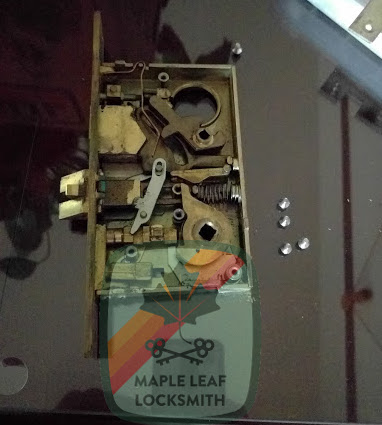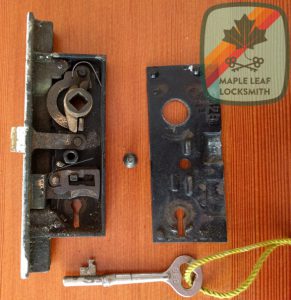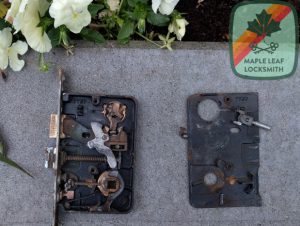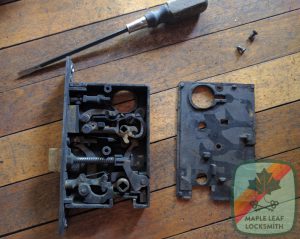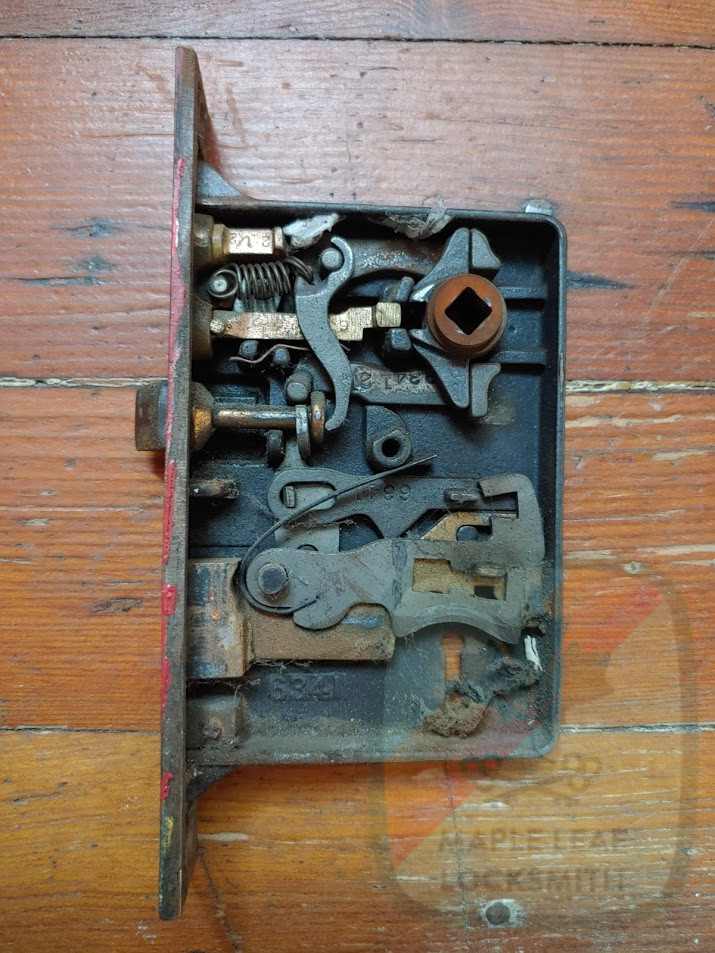Seattle has some buildings over 100 years old and many of these buildings are secured with mortise locks. These are locks that are modular in that you can install a mortise cylinder in any keyway you want and you can install many different kinds of trim to suit your particular aesthetic needs. Many of these old locks work beautifully for decades with no attention whatsoever. Sometimes they need a little help. You can bring it to me, I can come to you in Seattle, or if you’re outside of Seattle you can mail it to me.
If you do mail it to me all I need is the lock and the cylinder and the cylinder’s key, not the knob or the thumblatch unless you think that there is something wrong with those. Think about if you want to change the key that works with the lock to a different key in your house or to a high security key. This is possible with very old locks unless they are so old they use bit keys or skeleton keys as the public calls them.
I charge:
- $120 for a weekday service call in addition to…
- $95 per hour to fix mortise locks or 50% more on the weekend or evening
- $120 to modify a mortise lock to passage function (not locking) and install a deadbolt above
- $120 to retrofit a wood door with a doorknob, or
- $190 to retrofit a wood door with a doorknob and deadbolt
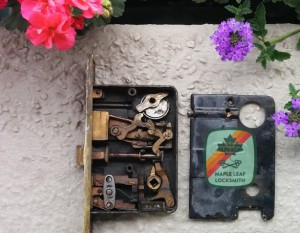 Sometimes people want me to replace mortise locks. I could make more money by replacing a mortise lock but I like to present the mortise lock’s case to the building homeowner before they make a final decision, because I love these working antiques. Probably no lock made today will last as long as the mortise lock in their door. If it is malfunctioning, it is only doing so after probably 50-100 years. There is probably not such a lock on the residential market that is capable of this now.
Sometimes people want me to replace mortise locks. I could make more money by replacing a mortise lock but I like to present the mortise lock’s case to the building homeowner before they make a final decision, because I love these working antiques. Probably no lock made today will last as long as the mortise lock in their door. If it is malfunctioning, it is only doing so after probably 50-100 years. There is probably not such a lock on the residential market that is capable of this now.
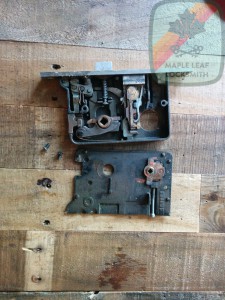 If you have what you think is a mortise lock, chances are that I can probably fix it. The usual problems that afflict the mortise lock are loose set screws, worn hubs, loose cam screws, or a stripped spindle/knob. I frequently fix mortise lock problems in less than half an hour. Properly lubricated and re-installed, my money is on a mortise lock lasting longer than anything you might buy at home depot.
If you have what you think is a mortise lock, chances are that I can probably fix it. The usual problems that afflict the mortise lock are loose set screws, worn hubs, loose cam screws, or a stripped spindle/knob. I frequently fix mortise lock problems in less than half an hour. Properly lubricated and re-installed, my money is on a mortise lock lasting longer than anything you might buy at home depot.
That said, there is a time and a place for replacing mortise locks. If the parts inside are extremely worn down and the lock is less common then replacement parts are hard to come by. In that situation the options are replace the mortise lock with a different one with the same dimensions or retrofit the door to use a modern knob.

The factors that favor keeping a mortise lock are that the old lock probably has aesthetic value. 100 year old locks have a patina that is not achievable without lots of work. They also typically have a lot of functionality, being able to switch between entry and storeroom function with the push of a button. Modern mortise locks are usually rated grade 1 locks, and I am sure that old mortise locks still in use probably rate just as highly when one considers how long they have lasted already. I charge $75 an hour to fix mortise locks, and since it usually takes me less than an hour to fix them you will save money having me repair it over replacing it with a modern lock.
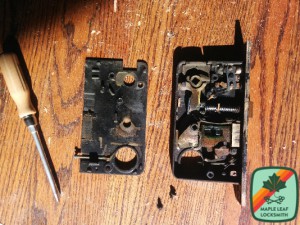
Another benefit of mortise locks is that they are mostly standardized in a few different spindle varieties and one cylinder diameter and thread pitch. This means that you can easily update the cylinder in a lock 100 years old to use the most modern keyways. I have installed my own CX-5 cylinders in them.
Factors in favor of replacing a mortise lock: when a mortise lock fails, it usually means that you can’t open the door, from the inside or the outside. The bolt may be stuck in the extended position with no way to retract it in normal usage. It can be a real chore to get the door open in these cases. Usually it means drilling out the cylinder and trying to manipulate the bolt through the cylinder hole using tools that have a ninety degree bend because you can’t manipulate the lock directly when it is in the door. If you have only one entrance then you may want to replace or modify your mortise lock. Another reason to replace a mortise lock is because all of the components are worn to the point of being too expensive to replace them. If the lock is a rare one it may be nearly impossible to replace lock components without expensive customised parts. This is not prohibitively expensive to the richest and most architecturally principled of my clientelle but is to most. A new mortise lock might be anywhere from $150-500 for a quality one.
Replacing a mortise lock is very expensive. Less expensive is to retrofit the door with a wrap around plate and either locking or passage tubular lock and a deadbolt. A retrofit job usually means a fresh installation (drilling new holes), a new tubular lock (either passage or entry/storeroom) and possibly a deadbolt (another fresh installation).

A nice middle ground is to keep the mortise lock and install a deadbolt above it. If the mortise lock is malfunctioning but the knob works well this is a great option. I can modify your mortise lock so that you can keep its aesthetic value but it won’t lock, while the deadbolt installed above it will secure the door. I can get deadbolts in nearly any finish to match the mortise lock’s trim, so your door will retain its pleasant look of yesteryear.

Many people around the world have found this website and asked if they may mail their mortise locks to me for fixing. The answer is yes. I am happy to fix your mortise lock and mail it back to you. Sometimes I am unable to fix a lock because the materials used to manufacture the lock have a lower melting point than the brazing rods I use. I have over a 90% success rate at replacing springs and also fixing or fabricating broken parts. I also have access to a good collection of mortise lock parts for replacement. As mentioned above, send broken parts along with your mortise lock. It is cheaper and faster for me to fix the lock that way.
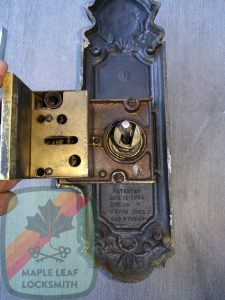
Unit locks are a different beast all together. They don’t use a standard lock cylinder that is still manufactured. I have fixed many of them but they are often more complicated than mortise locks. They are typically easy to convert to passage function though. These locks are very well built.
If you want to fix your own mortise lock it isn’t difficult for those with a knack for mechanical puzzles who aren’t afraid to get their fingers dirty. Before you pull it apart I recommend getting some nitrile gloves. There is probably 100 years of grime, graphite and grease inside your mortise lock and it does not come off easily. Mortise locks vary greatly in design so the only advice I can give the intrepid repair person is to video the process of taking the lock apart with their phone or other camera. There may be a time in the reassembly process where you have leftover springs and don’t know where they go. The easiest fixes are:
- If the latch sticks, the knob may be screwed on too tight. Try loosening the flathead screw on the base of your doorknob (it may be underneath the knob) and then rotating knob counterclockwise one full rotation and re-tightening the knob’s screw again.
- If the thumbturn for the deadbolt is causing the bolt to jam and lock you out when it’s in the wrong position, you may have a bad spring in your thumbturn disc. Ilco sells a replacement! Alternatively you could rig up some spring metal to always force the thumbturn back to the vertical position, which is what the spring in the disc is supposed to do anyway.
- The knob and/or the spindle may be stripped. The cheap hack fix is to wrap plumber’s tape around the spindle and put the knob back on. The proper fix is to replace the spindle and knob. Ilco makes replacement spindles for many different mortise locks. Interior mortise locks use a straight spindle and you can buy a set of glass knobs with spindle for $20 or less if memory serves. They sell them at regular hardware stores. You can buy a POS replacement for an entire bedroom/bathroom mortise lock at Home Depot, but they aren’t well made and the latch sticks if you turn the knob all the way to one side.
- The lock’s latchbolt or deadbolt doesn’t go into the respective hole in the doorframe. This is called a strike misalignment. This is possibly because the door is sagging. Try tightening the screws on the top hinge. If they don’t tighten (the wood is stripped) take one screw out and go buy screws of the same thickness but longer. If the lock still doesn’t line up with the strikeplate then the building may have shifted; try moving the strikeplate up or down a little bit but be careful: drilling too many pilot holes for your strike’s screws will erode the integrity of your doorframe and make it easier for somebody to kick the door in!
- The whole cylinder spins around when you put your key in instead of the smaller portion of the cylinder that is supposed to turn with your key. This is because a set screw is loose. Hopefully you can put the cylinder in the correct orientation and tighten the set screw (but don’t tighten it too much!). The set screw is on the edge of the door, sometimes hidden by a metal plate called an armor plate. If the screw doesn’t seem to tighten, it could be very bad news. The yoke that the screw is connected to may be broken or stripped because somebody overtightened the set screw. If you’re smart you’ll figure out how to make a new set screw and yoke with a threaded bolt and a threaded nut. This is entering PITA territory though, it’s time to consider calling in the experts.
